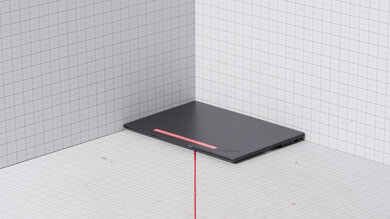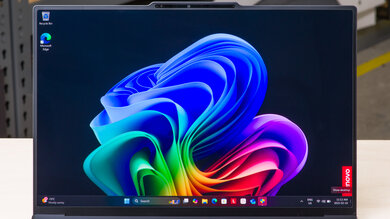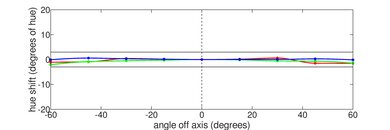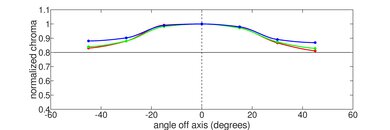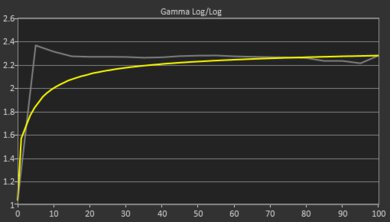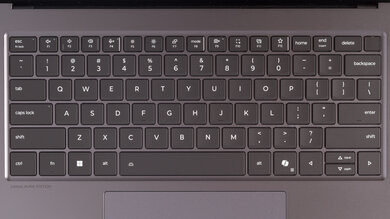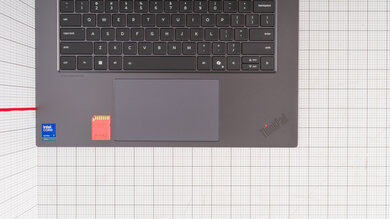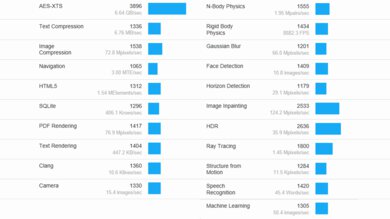The ASUS Vivobook 16 M1605 (2023) is a budget Windows laptop. It's available with various AMD Ryzen 5000 and 7000 U-series CPUs and integrated graphics. RAM and storage max out at 16GB and 1TB, respectively. It has an FHD+ (1920 x 1200) 16:10 IPS display, a full-size keyboard with a Numpad, a 720p webcam, and Wi-Fi 6E wireless connectivity. Ports include three USB-As, one USB-C, an HDMI, and a headphone jack. The USB-C supports charging but no video output.
See our unit's specifications and the available configuration options in the Differences Between Variants section below.
Our Verdict
The ASUS Vivobook 16 is decent for school use. Thanks to its thin and light design, it feels well-built and is easy to carry around. The display provides plenty of space for multitasking, the keyboard feels comfortable to type on, and the touchpad is large and responsive. Its AMD Ryzen CPU can handle most student workloads; however, its integrated graphics perform poorly, so it isn't ideal for students in fields like 3D graphics. As for its battery life, you can get through a typical 8-hour day of light use on a full charge, but if you do anything more intensive, you may need to plug it in for a short time.
-
Easy to carry around.
-
Battery lasts over eight hours of light use.
-
Screen provides plenty of space for multitasking.
-
Comfortable keyboard and large, responsive touchpad.
-
Integrated graphics can't handle demanding workloads.
-
Dim display not ideal for well-lit rooms.
-
Models with 8GB of RAM run in single-channel mode.
-
USB-C doesn't support video output.
The ASUS Vivobook 16 is mediocre for gaming. Although the Ryzen 7 processors provide a fair amount of CPU processing power, its integrated graphics aren't powerful enough to handle demanding games. The display has a 60Hz refresh rate and a slow response time, resulting in a blurry image in fast-moving scenes. On the upside, it supports FreeSync to reduce screen tearing.
-
No performance loss under load.
-
Fast SSD.
-
Doesn't get hot or loud under load.
-
60Hz display with slow response time.
-
Integrated graphics can't handle demanding workloads.
-
Models with 8GB of RAM run in single-channel mode.
The ASUS Vivobook 16 is mediocre for media consumption. It's easy to carry around, and its battery lasts over six hours of video playback, giving you plenty of time to get through a couple of full-length movies. Its 16-inch IPS display looks decently sharp; however, its low contrast makes blacks look gray in dim settings, and its narrow color gamut makes colors look a tad washed out. Unfortunately, although the speakers get very loud, they sound boxy and unnatural, with no bass.
-
Easy to carry around.
-
Battery lasts over six hours of video playback.
-
Speakers get very loud.
-
Dim display not ideal for well-lit rooms.
-
Colors look washed out.
-
Speakers sound unnatural with no bass.
The ASUS Vivobook 16 isn't designed for use as a workstation. Although you can get this laptop with an AMD Ryzen 7 CPU, which is fairly capable, its integrated graphics are far too slow for demanding workloads. Also, you can only get the laptop with up to 16GB of RAM, which might not be enough for some workloads. On the bright side, it has a comfortable keyboard and doesn't get hot or loud under load.
-
Ryzen 7 CPUs can handle some demanding workloads.
-
No performance loss under load.
-
Fast SSD.
-
Doesn't get hot or loud under load.
-
Integrated graphics can't handle demanding workloads.
-
Models with 8GB of RAM run in single-channel mode.
-
USB-C doesn't support video output or Thunderbolt 4.
The ASUS Vivobook 16 is good for business use. It's easy to carry, and its battery lasts long enough to get you through a typical 8-hour workday. It has a 16-inch display that's well-suited for multitasking, a comfortable keyboard, and a large and responsive touchpad. Its AMD Ryzen CPU can easily handle general productivity tasks like text processing, spreadsheets, presentations, and web browsing. Port selection is decent; the downside is that its USB-C doesn't support video output or Thunderbolt 4.
-
Easy to carry around.
-
Battery lasts over eight hours of light use.
-
Screen provides plenty of space for multitasking.
-
Comfortable keyboard and large, responsive touchpad.
-
Dim display not ideal for well-lit rooms.
-
Models with 8GB of RAM run in single-channel mode.
-
USB-C doesn't support video output.
- School
- Gaming
- Multimedia
- Workstation
- Business
- Updated May 02, 2024: We've updated the review for clarity and to provide more information regarding RAM configuration, as the laptop is available with 16GB of RAM.
- Updated Dec 07, 2023: Converted to Test Bench 0.8.2.
- Updated Nov 03, 2023: Converted to Test Bench 0.8.1.
- Updated Sep 26, 2023: Added mention of the Dell Inspiron 14 (2023) as an alternative with Thunderbolt 4 support in the Ports section.
- Updated Jun 08, 2023: Added mention of the Dell Inspiron 16 2-in-1 (2023) as an alternative with longer battery life in the Battery section.
- Updated May 16, 2023: Review published.
- Updated May 11, 2023: Early access published.
- Updated May 03, 2023: Our testers have started testing this product.
- Updated May 02, 2023: The product has arrived in our lab, and our testers will start evaluating it soon.
- Updated Apr 18, 2023: We've purchased the product and are waiting for it to arrive in our lab.
Differences Between Sizes And Variants
We tested the ASUS Vivobook 16 M1605 (model M1605YA-ES52) with an AMD Ryzen 5 7530U CPU, 8GB of memory, and 512GB of storage. The CPU, memory, and storage are configurable; the available options are in the table below. Our review applies only to variants with a model number starting with 'M1605Y'.
| Screen |
|
|---|---|
| CPU |
|
| GPU |
|
| Memory |
|
| Storage |
|
| Color |
|
See our unit's label here.
Compared To Other Laptops
The ASUS Vivobook 16 is a decent budget laptop. It has a better keyboard and touchpad than most laptops in its class. However, it has a dim display, so visibility may be an issue in well-lit settings.
For more options, check out our recommendations for the best business laptops, the best laptops for college, and the best budget and cheap laptops.
The ASUS Vivobook 16 M1605 (2023) is much better than the Acer Aspire 3 15 (2023) for most uses. The ASUS feels more sturdily built, providing a better user experience with a brighter display, a more comfortable keyboard, and a more responsive touchpad. It also has a better webcam and longer battery life and is available with faster CPUs.
The Apple MacBook Air 15 (2024) is much better than the ASUS Vivobook 16 M1605 (2023). Although both are ultraportables designed for light general productivity tasks, the MacBook is a high-end model with a more premium design and materials, while the ASUS is a budget-friendly model with an all-plastic build. The MacBook provides a better user experience, sporting a sharper, brighter display, a more comfortable keyboard, a larger haptic touchpad, better-sounding speakers, and a higher-resolution webcam. It also has significantly more processing power, allowing you to perform more demanding tasks like video editing, and its battery life lasts almost 13 hours in light use. The ASUS only lasts around eight hours.
The Lenovo IdeaPad Slim 3i 15 (2023) and the ASUS Vivobook 16 M1605 (2023) are both budget Windows ultraportables that offer a similar user experience. The ASUS comes out slightly ahead, as its keyboard feels more comfortable to type on, and its touchpad is larger and more responsive. However, the Lenovo has a wider port selection that includes a full-size SD card reader and support for video output via USB-C. Performance-wise, you can get more performance out of the Lenovo if you get a higher-end configuration with a Core i5 or i7. However, you likely won't notice much difference between these two laptops if you only perform light, general productivity tasks like web browsing and text processing.
The ASUS Vivobook 16 M1605 (2023) is better than the ASUS VivoBook 15 OLED K513 (2021) for most uses. The M1605 has a better keyboard and touchpad, and its battery lasts longer. However, the K513's OLED display has a higher contrast ratio and a wider color gamut, and it gets brighter to combat glare. The M1605's AMD Ryzen CPUs have better multi-thread performance than the K513's Intel CPUs, but you'll have to get a model with 16GB of RAM or upgrade it yourslef to get the most out of its CPU, as the 8GB models run in single-channel mode.
For most uses, the Dell Inspiron 16 2-in-1 (2023) is better than the ASUS Vivobook 16 M1605 (2023). The Inspiron 16 has a sturdier full-aluminum chassis, and it's a more versatile device since you can use it as a tablet. It has a more colorful display with full sRGB coverage, a better 1080p webcam, and a wider port selection with a second USB-C port. Also, unlike the Vivobook, the Inspiron 16's USB-C ports support video output. The Inspiron 16 has longer battery life; it lasts over ten hours of light use, whereas the Vivobook lasts only around eight.
The ASUS Vivobook 16 M1605 (2023) is much better than the Dell Inspiron 15 3000 (2020). The ASUS is available with newer and faster CPUs, providing a better user experience overall with a better keyboard and touchpad. It also has a better webcam, a faster SSD, and longer battery life. However, the Dell is more upgradeable, as it has two SO-DIMM memory and storage slots, whereas the ASUS only has one of each.
The ASUS Vivobook S 16 Flip TP3604 (2023) and the ASUS Vivobook 16 M1605 (2023) are both 16-inch ultraportables. The TP3604 is more versatile since it's a 2-in-1 convertible with stylus support, and it's available with more powerful H-series CPUs and a nicer 3.2k OLED display. It also has a higher resolution 1080p webcam and better-sounding speakers. On the other hand, the M1605 has longer battery life and doesn't throttle as much under load.
The ASUS Vivobook 16 M1605 (2023) is much better than the ASUS X515 (2020). The Vivobook 16 has a sturdier build, providing a better user experience as it has a more comfortable keyboard with backlighting, a larger and more responsive touchpad, and a much better webcam. Also, it's available with newer and faster CPUs, and its battery lasts longer.
Test Results
The ASUS Vivobook 16's design looks relatively sleek and professional. It has a compact chassis, thin bezels, a full-size keyboard with a Numpad, and a large touchpad with a fingerprint at the top right corner. On the bottom, you can find the speakers near the front and air vents near the back. There are also air vents on the left and back of the laptop. It's available in two colors: Indie Black and Cool Silver.
The build quality is good. Its all-plastic build doesn't feel premium, but it's sturdy, exhibiting only a little flex in the display and almost none in the keyboard deck or on the lid when the laptop is closed. While the finish is fairly scratch-resistant, it picks up fingerprints rather easily. If fingerprints and smudges bother you, the Cool Silver color variant is a better option, as light-color finishes usually fare better. The laptop's weight feels evenly distributed, and the feet feel solid.
The hinge is sub-par. It feels sturdy and smooth; however, there's a little too much resistance, and the screen wobbles when you bump into it or after adjusting the position.
The serviceability is good. Accessing the internals is easy; you only have to remove 11 Philips screws and undo the clips holding the bottom panel with a prying tool. Unfortunately, there's only one SO-DIMM memory slot because there's 8GB of RAM soldered onto the motherboard.
See the user's manual here.
- ASUS Vivobook 16 laptop
- 45W power adapter
- Documentation
The ASUS Vivobook 16 is only available with an FHD+ display. It looks decently sharp and provides plenty of space for multitasking. Its 16:10 aspect ratio is great for productivity, as its increased vertical space lets you see more information when reading a document or website, reducing the need to scroll.
The FHD+ display's 60Hz refresh rate is typical for a general productivity laptop. Its slow response time causes noticeable ghosting, which isn't ideal for viewing fast-moving content or gaming. It supports FreeSync to reduce screen tearing when gaming; however, the VRR range is quite small, as it only works between 45fps and 60fps.
The ASUS Vivobook 16's display has a great contrast ratio. It's at the higher end for an IPS panel but still relatively slow compared to other display technologies like VA and OLED. The contrast level makes blacks look gray in dim settings.
The display's maximum brightness is acceptable. It's fine for most indoor settings but isn't ideal for sunny rooms or outdoors in broad daylight. It gets very dim at the lowest brightness setting, which is great for dark room viewing as it causes less eye strain.
The display's reflection handling is decent. Its matte coating does a good job of diffusing bright, direct reflections like a lamp or open window during the day. However, unlike most glossy finishes, it causes a hazy, halo effect in other areas of the screen. Reflections aren't a problem when viewing light-color content with the screen at max brightness, but they make dark-color content hard to see.

The display's horizontal viewing angle is okay. The image dims and washes out relatively quickly as you move to the side. You must be almost directly in front of the screen to see an accurate image.

The vertical viewing angle is acceptable. Again, the image looks dimmer and more washed out from above or below. If you need perfect accuracy, you need to look at the screen more or less straight on, which can be hard in tight spaces with very little room to tilt the screen, like on a bus or airplane.
The display's out-of-the-box accuracy is sub-par. The white balance is alright, and the color temperature is a tad warmer than the standard 6500K target, giving the image a slight, almost imperceptible reddish tint. Color accuracy isn't bad; the main problem is that some colors look washed out due to the panel's narrow color gamut. This isn't a problem if you only look at text documents. Still, if you're consuming media or used to seeing higher-quality panels, like on an Apple iPad, you'll likely notice the lack of saturation a bit more. The gamma doesn't follow the sRGB curve at all. Most scenes look too bright, while dark scenes look too dark.
The display's color gamut is bad. It doesn't even have full coverage of the commonly used sRGB color space, making most content look washed out. Its Adobe RGB and DCI P3 coverage is also bad, so it isn't suitable for color-critical work like photo and video editing.
The ASUS Vivobook 16 has a great keyboard. The layout feels spacious and is easy to get used to. The keycaps feel okay in quality; they just pick up smudges and fingerprints easily. As for the typing experience, the keys have a lot of travel, don't require much force to actuate and provide fairly satisfying tactile feedback. Typing noise is relatively low and isn't bothersome in quiet settings. You can adjust between three backlight brightness levels or turn it off completely.
The touchpad is great. It's large, and it feels very smooth for a plastic touchpad. It tracks all movements and gestures well, with no palm rejection issues; however, dragging and dropping or zooming in and out of an image don't always work reliably. You can click anywhere on the touchpad, although the click mechanism doesn't feel particularly satisfying.
The speakers get very loud with very little dynamic compression at max volume, but they sound boxy and unnatural, with no bass.

The ASUS Vivobook 16 has a decent webcam. While the colors look relatively true to life, the captured image looks soft and slightly overexposed, with visible noise around some objects. As for the audio, voices come across loud and clear but slightly nasal and echoey.
The ASUS Vivobook 16 has a decent port selection. The USB-A port on the left supports USB 2.0 data transfer speed (up to 480Mbps), while the two on the right support USB 3.2 Gen. 1 (up to 5Gbps). The USB-C is also a USB 3.2 Gen. 1 port, and it supports Power Delivery, which allows for fast charging of the laptop and other PD-enabled mobile devices connected to the port. If you need a similar laptop with Thunderbolt 4 support, check out the Dell Inspiron 14 (2023).
The ASUS Vivobook 16 laptop's wireless adapter is a MediaTek MT7902. Wi-Fi 6E has faster speeds, lower latency, and less signal interference than previous Wi-Fi standards. However, to benefit from these features, you need a router that supports Wi-Fi 6E.
The ASUS Vivobook 16 is available with the following CPUs:
- AMD Ryzen 5 5625U (6 cores/12 threads, up to 4.3GHz, 16MB cache)
- AMD Ryzen 7 5825U (8 cores/16 threads, up to 4.5GHz, 16MB cache)
- AMD Ryzen 5 7530U (6 cores/12 threads, up to 4.3GHz, 16MB cache)
- AMD Ryzen 7 7730U (8 cores/16 threads, up to 4.5GHz, 16MB cache)
All four CPUs are designed for light to moderately demanding productivity tasks, like text browsing, web browsing, spreadsheets, and video playback. The Ryzen 5 7530U and Ryzen 7 7730U are essentially refreshed versions of the Ryzen 5 5625U and the Ryzen 7 5825U with faster base clock speeds. Clock speed bumps usually don't result in a significant performance boost, so choose the CPU according to the number of cores. A higher core count will result in a smoother experience, especially when running multi-threaded applications or multitasking.
The ASUS Vivobook 16 is only available with integrated graphics. These GPUs can only handle light productivity tasks, not demanding workloads like video editing or gaming. The Ryzen 7s' GPUs are faster than the Ryzen 5s'; however, the difference is small and isn't noticeable.
You can only get this laptop with 8GB or 16GB of RAM. It has 8GB of memory soldered onto the motherboard along with a SO-DIMM slot. 8GB of memory is fine for most people, but if you often have multiple applications running simultaneously, it's best to get a 16GB model or upgrade it yourself via the SO-DIMM slot. Also, know that the 8GB model runs in single-channel mode, which will limit the system's performance in memory-intensive tasks, so it's worth upgrading just so that the memory runs in dual-channel mode.
You can configure the laptop with 256GB, 512GB, or 1TB of storage. The SSD is user-replaceable; the slot supports M.2 PCIe Gen. 3 NVMe SSDs.
The ASUS Vivobook 16 scores well in the Geekbench 5 benchmarks. The AMD Ryzen 5 7530U performs well, but it's worth noting that the multi-thread performance is worse than expected because the memory is in single-channel mode. Upgrading the RAM to dual-channel will improve performance significantly. That said, even without a RAM upgrade, you can still get a fairly smooth experience when performing light productivity tasks like text processing, web browsing, and video playback. If you're a heavy multitasker or run more intensive applications, it's worth upgrading to a Ryzen 7 5825U or 7730U CPU, as their increased core count will result in a smoother experience overall. Unfortunately, the AMD CPU's integrated graphics perform poorly and aren't suitable for demanding tasks.
The ASUS Vivobook 16 laptop's AMD Ryzen 5 7530U performs well in the Cinebench R23 benchmarks. This level of performance is good enough for fairly heavy multitasking. If you need to run more intensive applications, it's best to upgrade to the AMD Ryzen 7 5825U or 7730U, as they have better multi-thread performance due to their increased core count. That said, if you're a professional working with strict deadlines, know that there are significantly faster CPUs on the market, like the Intel or AMD H-series processors used in mobile workstations and gaming laptops.
The AMD Ryzen 5 7530U performs well in Blender; however, if you need to render 3D images professionally, you're better off getting a laptop with a dedicated GPU. Even an entry-level GPU like an NVIDIA GeForce GTX 1650 renders faster than any of the CPUs available with this laptop.
The ASUS Vivobook 16 performs poorly in the Basemark GPU benchmark. None of the integrated GPUs can handle graphically demanding games. You can play some lighter puzzle-like or older titles, but you'll have to play at a lower resolution or with low settings to get playable frame rates.
If you want a similar laptop with longer battery life, check out the Dell Inspiron 16 2-in-1 (2023).
Borderlands 3 isn't playable. The game is too choppy, even with the lowest graphical settings. The AMD Ryzen CPU's integrated graphics aren't powerful enough to handle this and other similarly demanding games.
Civilization VI runs poorly at 1080p with high settings. The average frame rate is too low, even for a strategy game. However, it's playable if you lower some graphical settings. Upgrading to the AMD Ryzen 7 5825U or 7730U will only improve the turn time slightly.
CS:GO runs poorly. The game stutters a lot, regardless of the graphical settings. The AMD Ryzen CPUs' integrated graphics can't handle anything fast-paced, even an older title like this one.
Shadow of the Tomb Raider isn't playable at 1080p, even with low settings. None of the integrated GPUs can handle such a graphically demanding game. Also, the game can only run in DirectX 11 because it keeps crashing in DirectX 12. You can expect the same performance in other similar AAA titles.
The ASUS Vivobook 16 has great thermal and noise handling. The keyboard is cool when idle, and the fan is completely silent. Under load, the keyboard is only mildly warm, and while the fan is audible, the noise isn't distracting or annoying.
The ASUS Vivobook 16's performance over time is superb. Although the CPU gets fairly hot under load, there's no performance loss.
The ASUS Vivobook 16 has a few pre-installed applications, including:
- Alexa: Amazon's digital assistant.
- DTS Audio Processing: Lets you tweak the EQ settings and change the sound profile of the built-in speakers.
- GlideX: Lets you mirror your screen's content to a smartphone, tablet, or computer.
- McAfee Live Safe: Antivirus and internet security software. Requires subscription.
- MyAsus: Lets you access power, fan, and display profiles.
- ScreenXpert: Window management utility for multi-display setups.
- Solitaire Collection: Solitaire and other casual games.
- Spotify: App for music streaming service.





